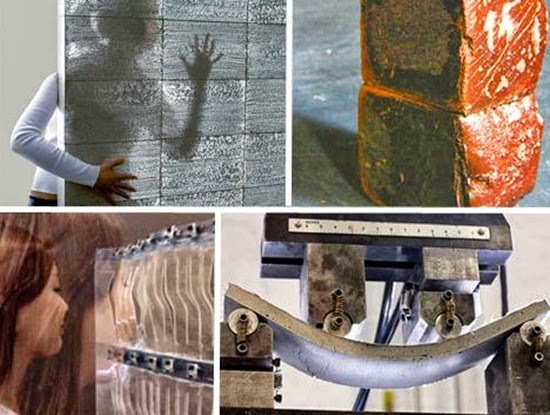16 FUTURISTIC BUILDING MATERIALS

Future
buildings could be made of artificial human bone, hemp, bacterial by-products or
concrete that absorbs greenhouse gas emissions and lasts thousands of years.
Innovations in building materials have led to synthetic creations that are
stronger, lighter and more sustainable than those we already use, potentially
leading to architecture unlike anything we’ve ever seen before.
1. Animal
Blood Bricks
Abundant
and yet almost always wasted, animal blood is an unlikely - and grisly -
possible base material for building bricks. Architectural graduate Jack Munro
sterilized the blood, added sand and baked them together to yield a strong,
traditional-looking brick that’s also waterproof.
2.
Translucent Concrete
Litracon is a combination of optical
fibres and fine concrete, produced as prefabricated building blocks for a
translucent glass-like look with surprising strength. It’s hand-made, so each
block has its own individual pattern of light.
3.
Bacteria Building Blocks
Will
bacteria build the walls of our
houses in the
future? Scientists have directed the creation of bio-plastics, cellulose and
other materials by feeding certain materials to specific varieties of bacteria.
The resulting metabolic process produces solid, surprisingly durable by-products
that could be used for all kinds of processes. Bacteria might even create bricks
that could be used for building on
Mars.
4.
Concrete That Lasts 16,000 Years
Not only
would the new concrete being developed at
MIT drastically
reduce the carbon emissions currently associated with the manufacturing of this
material, it would also result in an astonishing reduction in the amount needed
in the first place. That’s because it’s strong enough to last for an incredible
16,000 years. This concrete will not only be stronger, but also lighter and
thinner, so large-scale, lightweight structures require far less
material.
5.
Hempcrete: Hemp Biocomposite
A new
bio-composite, thermal wall material made of
hemp, lime and
water is not only eco-friendly but actually carbon-negative thanks to the amount
of CO2 stored during the process of growing and harvesting hemp. It’s 100%
recyclable, waterproof and fireproof and could be used for everything from walls
and insulation to flooring. Once demolished, the material can be used as
fertilizer.
6.
SensiTile
Sensitiles are made up of a
light-conducting matrix embedded in a substrate, so that they redirect and
scatter incoming light in a similar way as fibre optics. Shadow-producing
movements around these tiles produce an interesting rippling effect, and the
tiles absorb and ‘bleed’ colours.
7.
Bendable Concrete
A
new type of concrete
can not only
bend under 5% tensile strain, it does so by self-healing. The material forms
micro-cracks when bent, which then seal themselves after being exposed to water
and carbon dioxide.
8.
Water-Saving Bricks
What
looks like an ordinary red brick on one side contains a waterway that can route
water down the side of a building and into a basin for bathrooms, fountains,
cleaning, fire fighting or irrigation. The ‘Save Water’
brick is made of
pulverized fallen leaves and reclaimed plastic.
9.
Aerogel
So light
you can’t even feel it in your hand, aerogel has the lowest bulk density of
any known porous solid, and it’s a powerful insulating material. Made up of a
gel that has had its liquid component replaced by air, it’s thin, breathable,
fireproof, strong and won’t absorb water. Manufacturers are now producing it in
sheets as insulation, but it’s still pretty expensive.
10.
Electrified Wood
A
composite material made of pre-formed wooden elements and metal layers actually
enables lamps and other electronics to be plugged directly into the wood without
any cables. Developed by trans|alpin, the electrified wood
material could
revolutionize furniture.
11.
Liquid Granite
Safer at
high temperatures than concrete, but just as versatile, ‘liquid granite’ is made of 30-70% recycled
material and uses less than a third of the cement used in precast concrete. It
could be used in building projects that require the top level of protection
against fire.
12.
Novacem Carbon-Eating Cement
2.9
billion tons of cement is produced every year, and it’s responsible for up to 5%
of the world’s annual production of CO2. Novacem, a cement substitute made of
magnesium silicate, actually absorbs CO2 from the atmosphere. It could
potentially achieve one of the single largest reductions in CO2 emissions in
construction, cutting out 800kg of carbon emissions per ton of poured concrete
and absorbing another 50kg.
13.
Flexicomb
Made
from drinking straws, a disposable product, ‘flexicomb‘ is a flexible material that
form a translucent honeycomb matrix that could potentially be used to make
lighting fixtures and other items.
14.
Kinetic Glass
A new
material called ‘living glass’ could monitor CO2 levels in the
air, automatically opening and closing its ‘gills’ in response to the breathing
of humans in the room. It’s made of silicone embedded with wires that contract
due to electrical stimulus, allowing the gills to regulate air quality when
carbon dioxide levels are high.
15.
Zeoform: Recyclable, Low-Carbon
Using
nothing more than cellulose and water, this hardwood-like material is an
eco-friendly alternative to plastics and resins. Zeoform is made using a natural
glue-free process whereby cellulose fibres stick
together in water, and can be sprayed, moulded or shaped into a wide range of
objects.
16.
Artificial Bone
Human
bone is the inspiration behind a new high-tech
composite that
can be made in just a few hours using a 3D printer. Just as collagen and
hydroxyapatite help a natural bone withstand fracturing by dissipating energy
and distributing damage over a larger area, so do a soft black polymer and a
stiff blue polymer acting like a brick-and-mortar wall. The 3D printed bone
material is 22 times more fracture-resistant than any of its parts, and one day,
it could be used as the basis of entire buildings.





















No comments:
Post a Comment